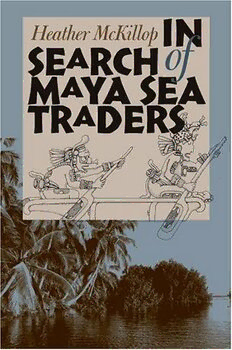
In Search of Maya Sea Traders PDF
Preview In Search of Maya Sea Traders
00-A3135-FM 9/2/04 11:35 AM Page i IN SE RCH a of M YA SEA a TR DERS a number eleven: Texas A&M University Anthropology Series D. Gentry Steele, Series Editor Series Advisory Board William Irons Eric Trinkaus Conrad Kottak Michael R. Waters James. F. O’Connell Patty Jo Watson Harry J. Shafer 00-A3135-FM 9/2/04 11:35 AM Page ii 00-A3135-FM 9/2/04 11:35 AM Page iii IN SE RCH a of M YA SEA a TR DERS a HEATHER McKILLOP texas a&m university press College Station 00-A3135-FM 9/2/04 11:35 AM Page iv Copyright © 2005 by Heather McKillop Manufactured in the United States of America All rights reserved First edition The paper used in this book meets the minimum requirements of the American National Standard for Permanence of Paper for Printed Library Materials, z39.48-1984. Binding materials have been chosen for durability. (cid:2)(cid:2) Library of Congress Cataloging-in-Publication Data McKillop, Heather Irene, 1953– In search of Maya sea traders / Heather McKillop. — 1st ed. p. cm. — (Texas A&M University anthropology series ; no. 11) Includes bibliographical references and index. isbn1-58544-389-1 (cloth : alk. paper)— isbn1-58544-424-3 (pbk. : alk. paper) 1. Wild Cane Cay Site (Belize) 2. Mayas—Commerce. 3. Mayas—Antiquities. 4. Excavations (Archaeology)— Belize—Punta Gorda Region. 5. Underwater archae- ology—Belize—Punta Gorda Region. 6. Coastwise naviga- tion—Belize—Punta Gorda Region. 7. Punta Gorda Region (Belize)—Antiquities. I. Title. II. Texas A&M University anthropology series ; no. 11. f1435.1.w6m35 2005 972.82(cid:3)401—dc22 2004010258 Unless otherwise indicated, all photographs and drawings are by the author. 00-A3135-FM 9/2/04 11:35 AM Page v To Bob, Eleanor, and Gordon 00-A3135-FM 9/2/04 11:35 AM Page vi 00-A3135-FM 9/2/04 11:35 AM Page vii CONTENTS Preface ix Acknowledgments xv part i. maya sea traders, 1981–1982 1 My First Visit to Wild Cane Cay, 1981 3 2 Fieldwork at Wild Cane Cay 17 3 Trips to Town and Visitors to the Cay 24 4 Household Archaeology 29 5 Obsidian Trade 41 part ii. wild cane cay, 1988–1992 6 Maya Ancestors: Keeping the Dead at Home 53 7 A New Dory 89 8 Underwater Archaeology 94 9 Volunteers 99 part iii. in search of other maya sites 10 In Search of the Coastal Maya 107 11 Returning to Wild Cane Cay in 1992 123 12 Provisions from Punta Gorda 127 13 Submerged Ancient Saltworks 131 14 Sea-Level Rise and Ancient Trade 137 part iv. frenchman’s cay, 1994 and 1997 15 Settlement Patterns 147 16 Target Practice 156 17 Rough Seas, Submerged Sites 161 18 Coral Architecture 171 19 Truce with the Sea 184 Notes 191 References 207 Index 219 00-A3135-FM 9/2/04 11:35 AM Page viii 00-A3135-FM 9/2/04 11:35 AM Page ix PREFACE The ancient Maya civilization of Central America has fascinated and perplexed scholars and the public alike for generations. The stone temples emerging above the rain- forest canopy, the rise and collapse of the civilization cen- turies before the sixteenth-century arrival of Europeans, and the elaborate hieroglyphs carved on stone monu- ments add to the appeal of this ancient culture. Less well known are the ancient Maya farmers who lived in smaller communities outside the great cities and who supported the “high culture” by food and labor taxes. Modern Maya Indians continue a traditional farming way of life perhaps little changed from ancient times. Few of them understand their ancient heritage or connection to archaeological sites that attract Western tourists, scholars, and students. The 1839 publication of Incidents of Travel in Central America by John Lloyd Stephens triggered widespread interest by the educated public in America and Europe in the ancient Maya civilization. This interest has re- mained unabated. National Geographic and Archaeology magazines, the Discovery and History channels, public television, and the Internet have enhanced public access to Maya archaeology. A variety of volunteer organiza- tions, notably Earthwatch, the Maya Research Program, and University Research Expedition Projects (UREP), among others, have engaged the public in fieldwork at Maya archaeological sites. Public lecture series such as the Maya weekends at the University of Pennsylvania, Tulane, and UCLA; the Maya Hieroglyphic Workshop at the University of Texas; and LSU Maya Archaeology Night bring Maya archaeologists and the interested pub- lic together to discuss the ancient Maya civilization. ix
